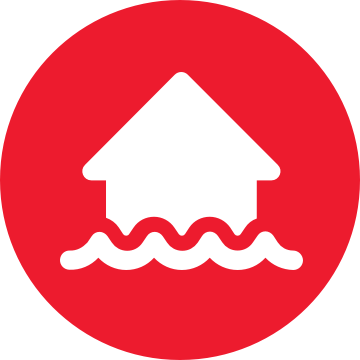Small Business Preparedness – Planning Tool – Preparing for Hazards
Preparing For Hazards
Let's review some simple safety steps on how to prepare your household and business to mitigate your hazard risks in your area.

Natural hazard are naturally occurring physical phenomena. They can be:
- Geophysical: a hazard originating from solid earth (such as earthquakes, landslides, and volcanic activity).
- Climatological: relating to the climate (such as droughts and wildfires).
- Meteorological and Hydrological: relating to weather conditions (such as cyclones and storms) or caused by the occurrence, movement and distribution of water on earth (such as floods and avalanches).
- Biological: caused by exposure to living organisms and their toxic substances or diseases they may carry (such as disease epidemics and insect/animal plagues).
- Man-made and Technological: events that are caused by humans and occur close to human settlements. They include complex emergencies, conflicts, industrial accidents, transport accidents, environmental degradation and pollution.

Drought
Drought is a long lasting period of low precipitation (rainfall, snowfall or snowmelt) resulting in a shortage of water.
When communities don't have enough water for drinking, sanitation and agriculture, it can lead to food insecurity, the spread of disease, malnutrition and starvation, migration, and economic losses. Drought can also have a negative impact on power generation, transportation and commercial or industrial needs in a country.
Heat Wave
A heat wave is an extended period of unusually high temperatures and often high humidity.
They are expected to become more frequent and more severe in the future due to climate change. People affected by heat waves can suffer shock, become dehydrated and develop serious health illnesses. Heat waves can also worsen chronic cardiovascular and respiratory diseases.


Cold Wave
A cold wave, sometimes known as a cold snap or deep freeze, is a weather event involving a cooling of the air, or the invasion of very cold air, over a large area.
It is marked by a drop of average temperature well below the averages of a region. Cold waves can have negative impacts of people, crops, properties and services. They can be preceded or accompanied by significant winter weather events, such as blizzards or ice storms. And they can feel even colder during period of high winds.
Epidemic
Epidemics are an unexpected, often sudden, increase of a specific illness within a community or region. Pandemics are when an epidemic occurs worldwide, crossing international borders and affecting a large number of people.
A number of communicable diseases can be significant health threats at the local, regional and global level and lead to epidemics or pandemics. Epidemics and pandemics can be prevented and mitigated through a range of household and community measures, such as good hygiene, social distancing and vaccination.


Avalanche
An avalanche, sometimes called a snowslide, is the rapid flow of snow, ice and/or rock down a slope or mountain.
They can be triggered by natural forces such as precipitation, earthquakes or the weakening of snowpack (layers of snow that accumulate in areas of high elevation and cold temperatures). They can also be caused by human activity when someone walks or rides over a weak area of snow. Slab avalanches - when a large slab of stronger ice or snow dislodges from on top of a waker snow layer - are the most dangerous. Avalanches can obstruct everything in their path, destroy entire buildings and lead to serious injury and death.
Earthquake
An earthquake is a sudden and rapid shaking of the ground caused by the shifting of rocks beneath the earth's surface, or by volcanic or magmatic activity in the earth.
Earthquakes strike suddenly, without warning, and can occur at any time. They can lead to death, injuries, property damage, loss of shelter and livelihoods and disruption of critical infrastructure. Most deaths are due to building collapsing or to secondary hazards, such as fires, tsunamis, flooding, landslides and release of chemical or toxic materials.


Landslide
A landslide or landslip is the mass movement of rock, debris, earth or mud down a slope.
While most landslides are caused by gravity, they can also be caused by rainfall, earthquakes, volcanic eruptions, groundwater pressure, erosion, destabilization of slopes as a result of deforestation, cultivation and construction, and snow or glacial melt. Debris flows, or mudflows, are fast-moving landslides that are especially dangerous due to their speed and volume. Some debris flows have been recorded as reaching speeds of over 160 kilometers per hour.
Tsunami
A tsunami is a sea wave triggered by a large-scale displacement of the sea floor. They are most commonly caused by earthquakes but can slso be caused by major underwater (or submarine) landslides or volcanic eruptions.
They can strike any coast at any time. Tsunamis can move as fast as a jet plane across the open ocean and can hit land with waves higher than 20 meters. Water can wash inland for several kilometers in flat lying area and move streams and rivers, destroying everything in its path. Waves may continue to strike the shoreline for many hours and dangerous currents can continue for several days. Although a tsunami can't be prevented, its impact can be reduced when communities understand the risks, receive timely warnings and know how to respond.


Volcano
A volcano is an opening or rupture in the earth's surface that allows magma (hot liquid and semi-liquid rock), volcanic ash and gasses to escape. They are generally found where tectonic plates come together or separate but they can also occur in the middle of plates due to volcanic hotspots.
A volcanic eruption is when lav and gas are released from a volcano - sometimes explosively. The most dangerous type of eruption is called a 'glowing avalanche' which is when freshly erupted magma flows down the sides of a volcano. They can travel quickly and reach temperatures of up to 650 degrees Celsius. Other hazards include ash fall, and lahars (med or debris flows). Volcanoes often cause population displacement and food shortages.
Tropical Storm
Tropical storms are rapidly-rotating storm systems that rotate (counter-clockwise in the Northern Hemisphere and clockwise in the Southern Hemisphere) around a low pressure center.
They are generally slow moving but sever, with winds of between 120-320 kilometers an hour, They have different names depending on where they happen; cyclones in Southeast Asian waters and the Indian Ocean, typhoons in East Asian and Pacific waters and hurricanes in the Atlantic, Gulf of Mexico or Caribbean Sea. Most cyclone-related deaths are from flooding, but also from electrocution, collapsed structures and blowing debris.


Flood
Floods are when water overflows from the normal boundaries of a stream, river or other body of water or accumulates in an area that is usually dry. There are two main types of floods; inundation flood are slow, developing over hours or days, while flash floods occur suddenly, often without warning, usually due to heavy rain.
Though annual flooding is a natural phenomenon in many parts of the world, human habitation and land-use practices have led to an increase in frequency and magnitude of floods. Floods are also predicted to become even more frequent and sever in future due to climate change. Floods can be extremely dangerous and cause massive human, environmental and material damage to communities.
Thunderstorm and Hailstorm
Heavy rain from thunderstorms can cause flash flooding, and high winds can damage properties and blow down trees and utility poles, causing widespread power outages.
Hail is a type of solid rain made up of balls or humps of ice. Storms that produce hail which reaches the ground are known as hailstorms. They typically last for no more than 15 minutes but can cause injuries to people and damage buildings, vehicles and crops. When hail builds up, it can cause flash floods and mudslides in steep areas. On rare occasions, massive hailstones have been known to cause concussions and fatal head injuries.


Wildfire
Wildfires (also known as bushfires, brush fires or forest fires) are large, uncontrolled and potentially destructive fires that can affect both rural and urban areas.
They can spread quickly, change direction and even 'jump' across large distances when embers are sparks are carried by the wind. They are caused by a range of natural causes (such as lightning) or by human carelessness (such as a discarded cigarette). The spread of a wildfire depends on the arrangement of land, available fuel (vegetation or dead wood) and weather conditions (wind and heat). They can start in just seconds and turn into infernos in a matter of minutes.
Critical Infrastructure Failure
There are many potential reasons to cause infrastructure to fail - it could be due to natural hazards, social/political/economic instability, transportation accidents, etc.
Critical infrastructure systems that could be affected are: transportation systems, communication systems, energy, water, waste management, health and safety, etc. Planned or unexpected, critical infrastructure failure can be a great disturbance to households and businesses wit the potential of lasting impacts.


CBRN
Technological hazards originate from technological or industrial conditions, dangerous procedures, infrastructure failure or human activity. Chemical, biological, radiological and nuclear (CBRN) hazards are all types of technological hazards.
They are commonly grouped together because they share a lot of similarities, and many of the preparedness and response measures are the same or very similar. Learn more about these specific hazard types below:
Structure Fire
Home fires are one of the most common type of emergency worldwide and can cause deaths, injuries and property loss within minutes of breaking out. Home fires occur every day, but we can take action to prepare. Prepare now to protect yourself, your loved ones, and your property.

Risk Assessment
Businesses conduct risk assessment to identify the hazards that have the potential to adversely affect their ability to operate.
Now that you've identified your hazard risks and the actions you can take to prepare, click here for the risk assessment and follow the instructions to complete your own risk assessment. Once you understand your vulnerabilities, this planning tool will help prepare your business to better withstand the impact of hazards, reduce disaster risks, and build resilience.
